Last Updated on: 13th January 2025, 01:54 pm
Located in the western part of Yellowstone, Norris Geyser Basin is home to hundreds of hydrothermal features like geysers, mud pots and fumaroles. While it may not be as well-known as Upper Geyser Basin (known for Old Faithful) or Middle Geyser Basin (Grand Prismatic), it’s easily one of the most interesting hydrothermal areas of the park.
Situated just outside the Yellowstone Caldera, Norris Geyser Basin sits at the intersection of the Norris-Mammoth fault and the Hebgen Lake fault. It’s considered to be Yellowstone’s oldest geyser basin and also its most acidic. And as we’ll cover below, it’s even home to the tallest active geyser in the world!
The area was named after Philetus Norris, a former fur trapper and the second superintendent (and first to be paid) of Yellowstone National Park.
Norris Geyser Basin can get fairly crowded, and it’s generally advised to arrive early to find a parking space. With that said, I did manage to find something in the middle of the afternoon.
Not far from the parking lot, be sure to check out the informative museum before starting your adventure.
Norris Geyser Basin consists of two main sections: Back Basin and Porcelain Basin. Exploring both in full should take you a little over two hours.
For more information on Yellowstone tours and accommodation, be sure to check the end of the article.
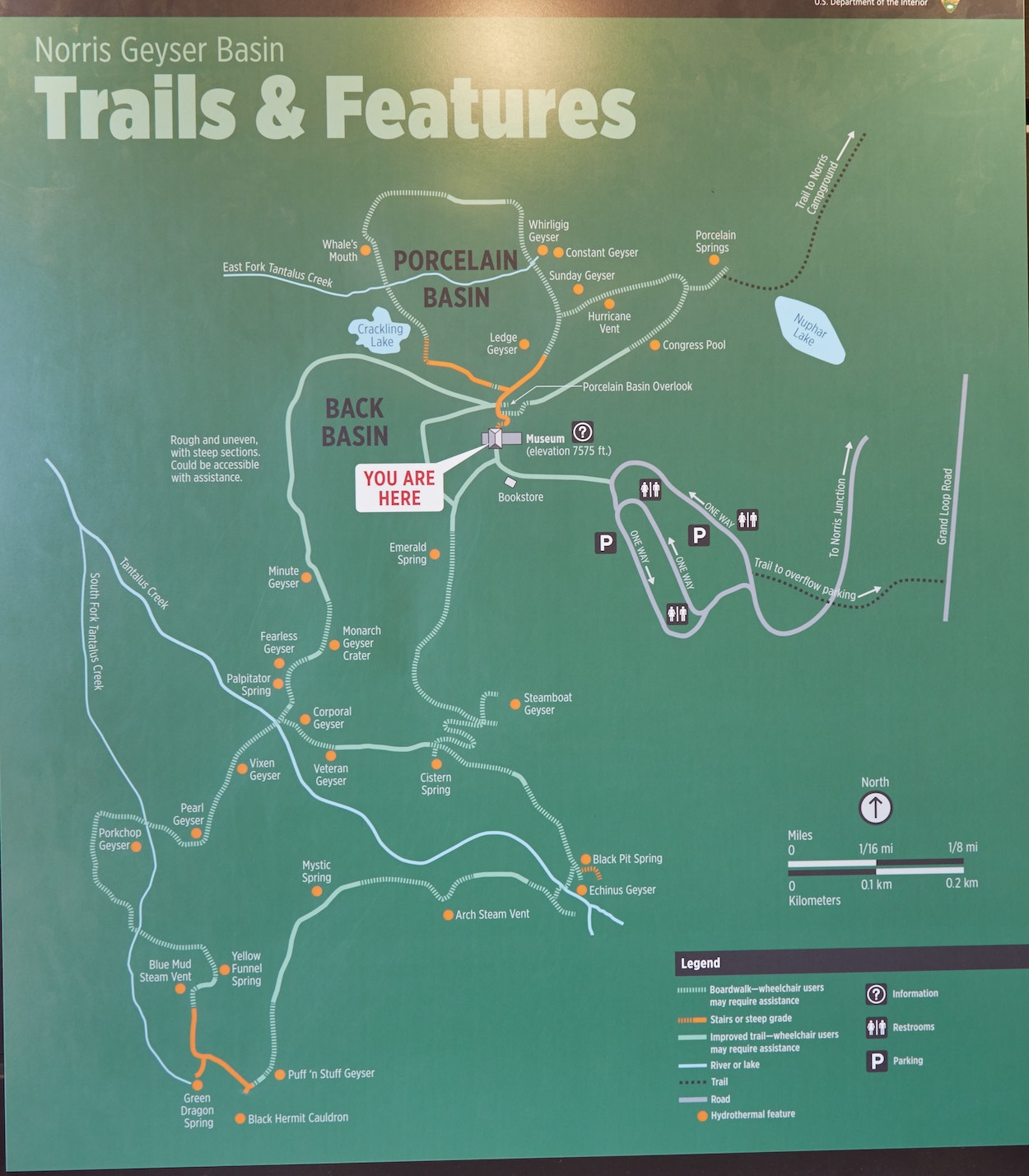
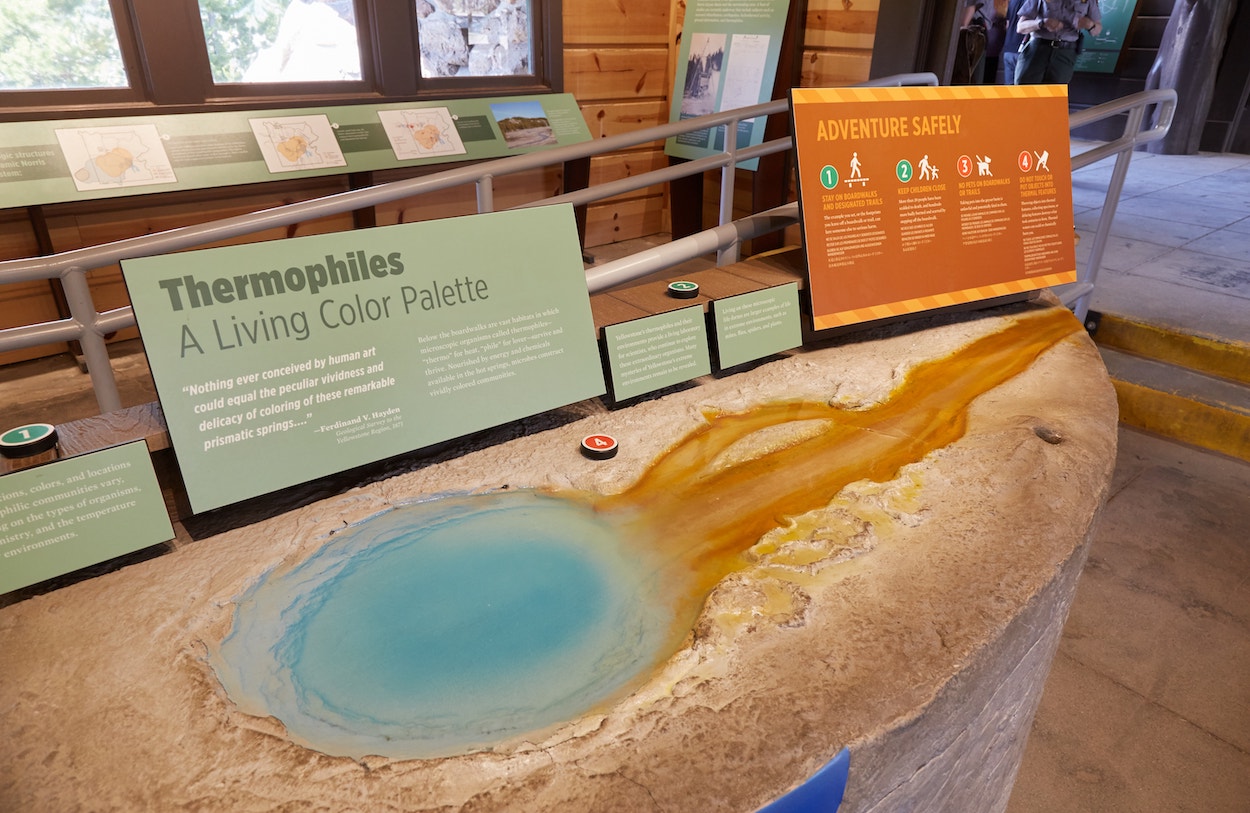
Porcelain Basin
As mentioned, Norris Geyser Basin consists of two main areas. While you can start with whichever area you like, I decided to begin with Porcelain Basin, the smaller of the two.
In total, it’s just a 0.6-mile (1 km) loop. Past the small museum, you’ll want to take a right, and the path which will gradually take you downhill and into the basin.
As you’ll soon observe, this area is so hydrothermally active that even the hillside is venting!
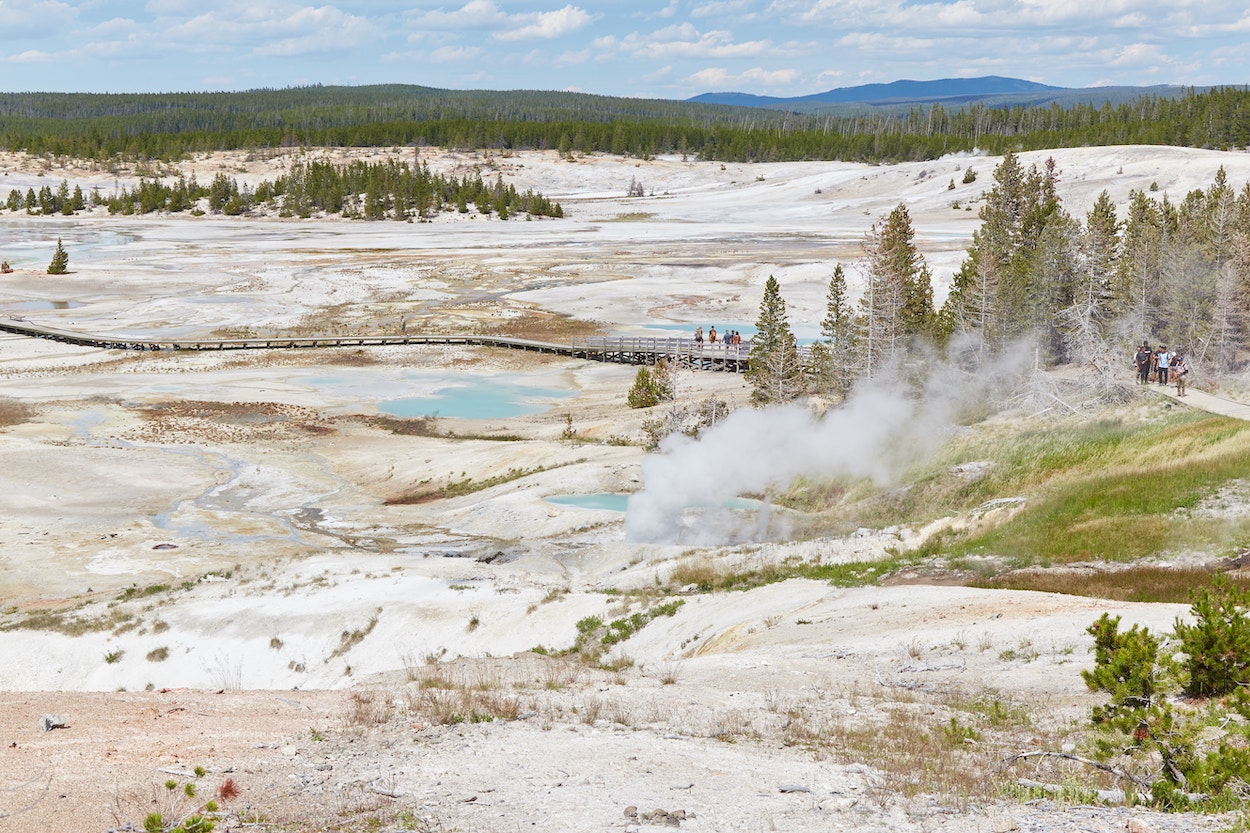
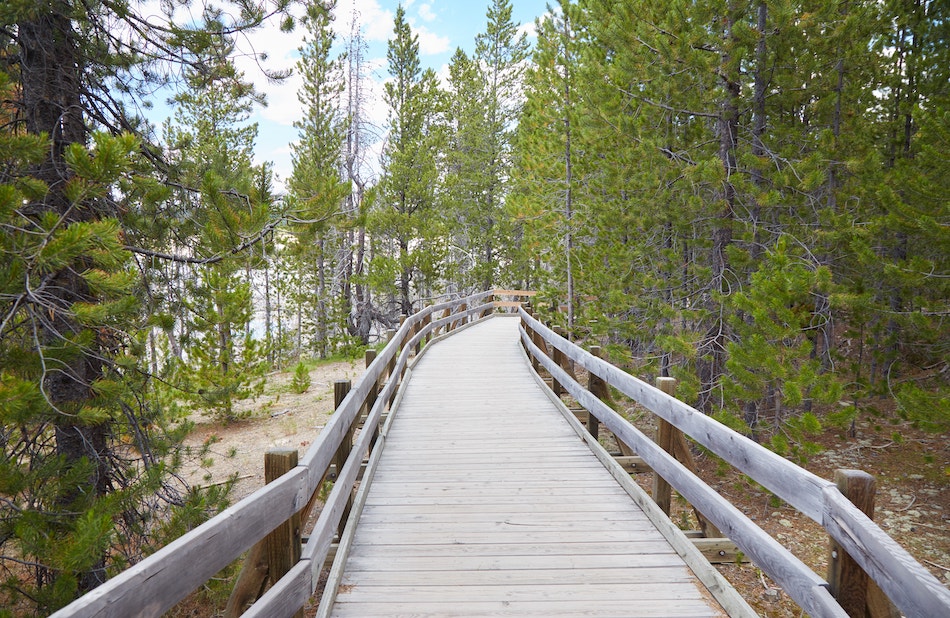
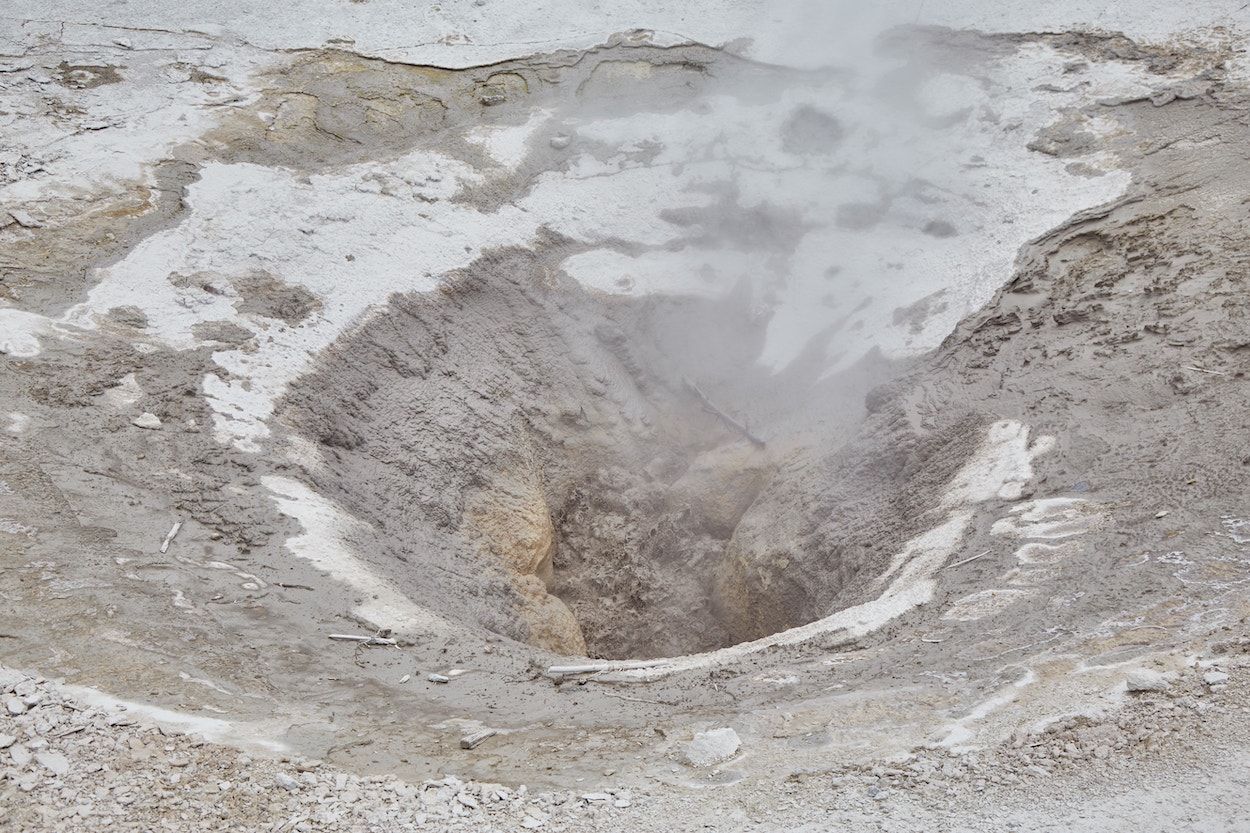
Near the beginning, you’ll walk past a small spring known as Congress Pool. But the real highlight of the area is the beautiful array of colors in the central part of the basin.
The various colors here – and elsewhere at Yellowstone – are caused by microscopic organisms that are somehow able to survive in these extreme temperatures.
The pools of water that are murky, meanwhile, are the result of the presence of silica.

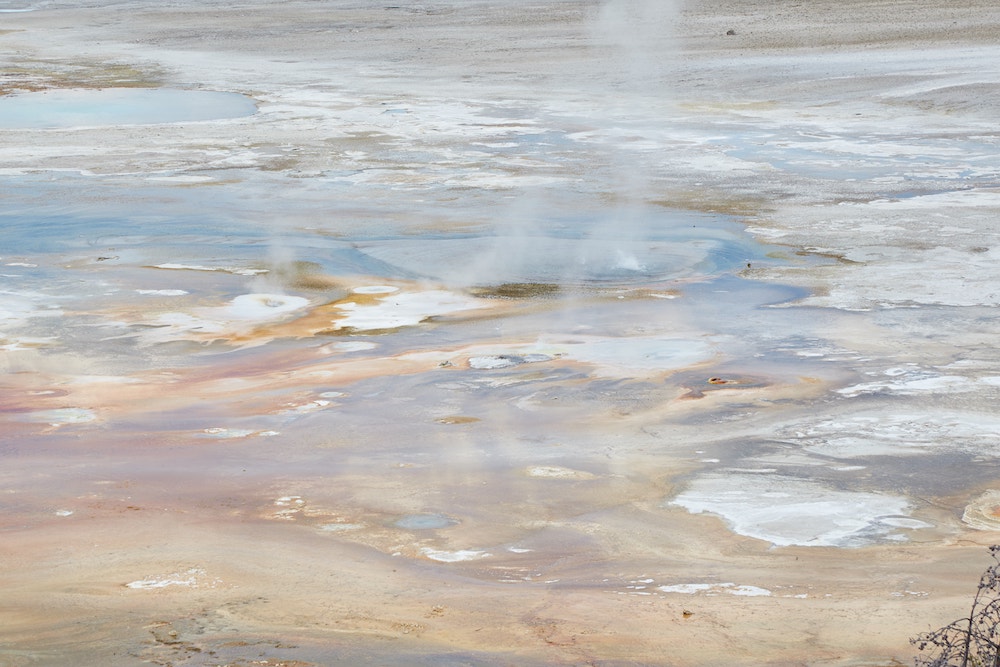

Norris Geyser Basin is said to be the most frequently and rapidly changing of Yellowstone’s geyser basins. And passing a sign for the Norris Campground, the entire path there was flooded!
While exactly what caused this is unclear, according to the NPS website, the campground is now permanently closed as of 2024.


Moving along, you’ll encounter the Hurricane Vent, which was once categorized as a geyser but is now considered a steam vent. Also nearby are the murky Colloidal Pool and the Sunday Geyser, which also appears as a pool.


But how, exactly, did all these features form? Yellowstone’s hydrothermal activity is fueled by magma beneath the earth, and the heat is constantly looking for a way out. And hot water that smoothly flows to the surface is what we call a hot spring.



As for geysers? Geysers are just like hot springs, except that complicated ‘plumbing systems’ caused a buildup of pressure. And this pressure buildup eventually results in eruptions.
Speaking of eruptions, you probably won’t see as much activity at Norris Geyser Basin as you will at Upper Geyser Basin. But what makes this area really special is both the huge size of the basin and its pretty colors.





Eventually, the boardwalk will take you back to the starting point of the loop. And from here, you can immediately transition to the Back Basin loop.
But if you need to get something from your car, it also won’t be difficult to make a quick stop back at the parking lot.


Back Basin

At 1.6 miles (2.6 km), the Back Basin loop is considerably larger than that of Porcelain Basin. But it’s well worth exploring in full, as it’s home to some of the area’s more unique hydrothermal features.
While you can walk the loop in either direction, I decided to do it clockwise (when facing south), first arriving at the Emerald Spring.

Emerald Spring is one of the highlights of the area, with its color being the result of sulfur deposits combined with the blue light reflected by the sun.
While many of the springs at Yellowstone take on the color of the refreshing water you’ll find at beaches in the topics, this water is anything but refreshing.
Norris Geyser Basin, in fact, is the park’s hottest area. The highest-ever surface temperature measured here was 290.4° F (138° C), with the subterranean temperature reaching up to 464° F (240° C)!


Soon you’ll walk past Steamboat Geyser – the very tallest active geyser on the planet. During major eruptions, water can shoot up to 300 ft (91 m) in the air. Large amounts of steam will then come out for hours or even days.
Major eruptions, in fact, can be so massive that when arriving at the Norris Geyser Basin parking lot, you’ll find warning signs about how your vehicle could potentially get damaged!
Minor eruptions also occur, sometimes reaching up to 40 ft (12 m).
Intervals between major eruptions of Steamboat Geyser can last anywhere between three days to 50 years. At the time of my visit, I’d missed the last eruption by about a month, according to a posted sign.

Another beautiful spring in the area is Cistern Spring. Interestingly, it sometimes appears blue and other times clear, and during my visit it was the former. The spring is actually linked underground with Steamboat Geyser.
Past Cistern Spring, you’ll find that the boardwalk forks, with one path cutting through the middle of the main Back Basin loop, taking you to additional geysers such as Veteran and Corporal Geysers. But I decided to save those for the end.


Proceeding with the main loop, you’ll encounter features like the Echinus Geyser, Black Pit Spring, Crater Spring and Arch Steam Vent, Puff ‘n Stuff Geyser, and more.
Despite being rather crowded in the areas near the parking lot, only a handful of other visitors ventured out this far on the day of my visit.


But that’s a shame, as the far end of the loop is where you’ll find one of Back Basin’s most interesting features: Green Dragon Spring. In one spot, you’ll find a deep pool like those described above in addition to water coming out of a smokey cave. It does indeed resemble a dragon’s lair.
For similar-looking caves, also be sure to visit Mud Volcano on the opposite side of the park.



Continuing along the boardwalk, you’ll encounter more unnamed yet strikingly beautiful landmarks. Multicolored streams flow through the basin, almost appearing like spilled paint.


Other popular features around here include Porkchop Geyser and Pearl Geyser. As mentioned above, Norris Geyser Basin is one of the most dynamic basins at Yellowstone.
One reason for the rapid changes is that about every year, a subterranean eruption occurs beneath the surface which can bring visible changes to various hydrothermal features.
As such, well-known features might not always live up to the hype depending on what year you visit. On the other hand, you might find some of the lesser-known geysers to appear the most interesting.



As mentioned earlier, the boardwalk cuts through the main loop of Back Basin, which I decided to save for my return trip. Here I encountered Corporal Geyser, which happened to be one of the most active features at the time of my visit. It was well worth the detour.


The rest of the loop, meanwhile, takes you past features like Minute Geyser. Sadly, rocks were thrown into it by careless visitors at a time when the main road came right up to this area.
While this geyser used to regularly erupt every minute, eruptions are now quite irregular due to human intervention.

Finally, the trail will start taking you uphill again, and you can enjoy one last look at Norris Geyser Basin from above before returning to your car.
If you’re wondering how to fit a visit here into your itinerary, it’s fairly easy to combine with Grand Canyon of the Yellowstone on the same day. Alternatively, you can also combine it with Mammoth Hot Springs further north.
Be sure to check our detailed Yellowstone Itinerary to learn more.
Additional Info
Even with a comprehensive guide, planning a trip to Yellowstone can be overwhelming considering all there is to do and see. That’s where guided tours can come in handy.
If you’re short on time, this highly-rated tour takes you to various parts of the park, such as Norris Geyser Basin, Upper Geyser Basin (for Old Faithful) and Grand Canyon of the Yellowstone. It also takes you through Hayden Valley, one of the best places for spotting wildlife.
At around 2.2 million acres, Yellowstone National Park is absolutely massive, and there are few cities or towns right by the park. And even if there were, you’d still want to change locations at least once to easily make it to all the main areas.
Rather than present an exhaustive list of all the different options and variables, I’ll explain what my travel companions and I did. In the end, I’m very pleased with the way the trip worked out. What follows is a brief summary, but you can learn more details in our comprehensive Yellowstone Itinerary.
Yellowstone should be explored over the course of three or four days. Assuming you can spend four nights in the region, it’s best to camp within the park and to do so at two different locations.
Not only will this save you money, it will also save you a lot of driving time. It also makes it possible to observe wildlife at dusk and dawn.
Note that driving in Yellowstone in the dark is not advised due to the lack of lighting and presence of large animals on the road. As such, you can count out staying in a nearby town and getting a head start by departing before sunrise.
Coming immediately from Grand Teton National Park, I entered Yellowstone via the South Entrance and headed straight for the Grant Village Campground. The next day, after exploring the geysers of southwest Yellowstone, I spent another night at the same campsite.
The following morning, we packed up our things and explored Yellowstone Lake and nearby areas. That night was spent at the Canyon Village Campground, located in the east part of the park where the two main loop roads intersect.
Again, we spent two nights in total at the same campground, allowing easy access to the Grand Canyon of the Yellowstone. It was also within reasonable driving distance of Mammoth Hot Springs on the final day. (We’d then head north into Montana).
Yellowstone’s campgrounds are run by the Xanterra Corporation, and you can make reservations at this link.
Both campgrounds I stayed at had shower areas, though they unfortunately weren’t within walking distance of the campsite. There were plenty of bathrooms in the main camping areas, however.
Note that you can also find proper hotels/lodges at both Grant Village and Canyon Village. But not only can they get very pricey, you’d have to book many months in advance to secure a spot. On that note, even camping sites should be booked several months ahead of time.
At the time of writing, Yellowstone costs $35 to enter (learn more here).
If you’re visiting from abroad, note that in contrast to many other countries, US parks typically charge per vehicle rather than per person. However, if you’re traveling by bicycle instead, they’ll charge you for an individual pass which costs $20, while those on motorcycles will be charged $30.
Considering how many National Parks and National Monuments there are to see in the Southwest alone, the best option for most will be to buy an ‘America the Beautiful’ Annual National Parks Pass.
These cost $80 for the year. In most cases, you’re already saving money by just visiting four National Parks/Monuments anywhere in the country within a full year.
What’s more, is that only one person in your vehicle needs to have the pass. Additionally, seniors can buy the pass for just $20. So if you have someone over 62 in your party, just have them get the annual pass and everyone else will be set.
As for where to get the pass, you can purchase it in person at most National Parks or Monuments. But you can also order it in advance online.
Fortunately, a park pass/entry ticket is all you need to visit Yellowstone right now, as the park has not implemented any permit or timed entry systems like other popular parks have.
The guide above is just one of many Yellowstone-related articles on this website. Just starting out with planning and aren’t sure where to begin? These articles have got you covered:
- Top 5 Things to Do in Yellowstone
- The Perfect 4-Day Yellowstone Itinerary
- Yellowstone: The Ultimate Packing List
And here’s a list of our other location-specific Yellowstone guides:
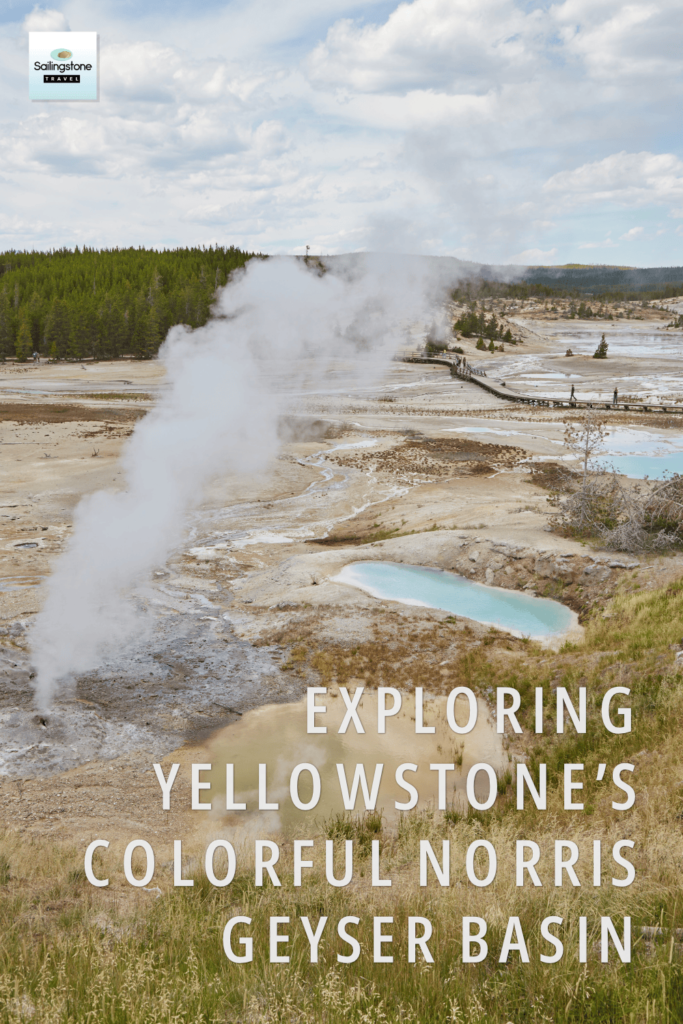
Pin It!
